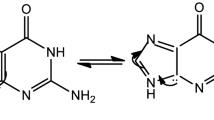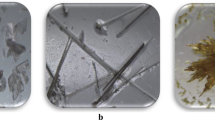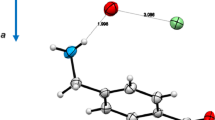Abstract
A series of lanthanide complexes [Ln(4-Cl-2-MOBA)3phen]2 (Ln=Sm (1), Nd (2), Ho (3), Eu (4), Dy (5), and Tb (6); 4-Cl-2-MOBA=4-chloro-2-methoxybenzoate, phen=1,10-phenanthroline) were synthesized and characterized. The single-crystal X-ray diffraction demonstrates that 1–3 are isomorphous, which present dimeric structures with four 4-Cl-2-MOBA anions function as bridging ligands. Complexes 1 and 4–6 display their characteristic luminescence emission bands of central Ln3+ ions. The heat capacities, the thermodynamic functions and the thermogravimetry–Fourier transform infrared spectra of gaseous products of complexes 1–6 were investigated. Their non-isothermal kinetics of the second decomposition stage was studied by the integral isoconversional non-linear method and Stark method. Furthermore, 1–6 exhibited excellent antibacterial activity against Candida albicans, Escherichia coli and Staphylococcus aureu.







Similar content being viewed by others
References
Song XZ, Song SY, Qin C et al (2012) Syntheses, structures, and photoluminescent properties of coordination polymers based on 1,4-bis(imidazol-l-ylmethyl) benzene and various aromatic dicarboxylic acids. Cryst Growth Des 12:253–263
Bunzli JCG (2006) Benefiting from the unique properties of lanthanide ions. Acc Chem Res 39:53–61
Aspinall HC (2002) Chiral lanthanide complexes: coordination chemistry and applications. Chem Rev 102:1807–1850
Tsukube H, Shinoda S (2002) Lanthanide complexes in molecular recognition and chirality sensing of biological substrates. Chem Rev 102:2389–2404
Adachi G, Imanaka N, Tamura S (2002) Ionic conducting lanthanide oxides. Chem Rev 102:2405–2430
Wang Z, Bai FY, Xing YH et al (2010) Two new 3D lanthanide coordination polymers with benzenesulfonic and adipic acids: synthesis, structure and luminescent properties. Z Anorg Allg Chem 636:1570–1575
Pang X, Li DC, Peng A (2002) Application of rare-earth elements in the agriculture of China and its environmental behavior in soil. Environ Sci Pollut Res Int 9:143–148
Fedin VP, Kalinina IV, Virovets AV et al (2003) Syntheses and structures of layered compounds based on lanthanides(III) and cubane molybdenum and tungsten telluride cyano complexes. Chem Bull 52:126–131
Li HH, Niu Z, Han T et al (2011) A microporous lanthanide metal-organic framework containing channels: synthesis, structure, gas adsorption and magnetic properties. Sci China Chem 9:1423–1429
He QZ, Yang J, Min H et al (2006) Studies on the spectra and antibacterial properties of rare earth dinuclear complexes with L-phenylalanine and o-phenanthroline. Mater Lett 60:317–320
Oliveira LH, de Moura AP, Longo E et al (2013) Luminescent properties of hybrid materials prepared by the polymeric precursor method. J Am Ceram Soc 579:227–235
Lin JT, Huo JS, Cai YP et al (2013) Controllable synthesis of Eu3+/Tb3+ activated lutetium fluorides nanocrystals and their photophysical properties. J Lumin 144:1–5
Hou HW, Wei YL, Song YL et al (2004) First octameric ellipsoid lanthanide(III) complexes: crystal structure and nonlinear optical absorptive and refractive properties. Inorg Chem 43:1323–1327
Geary WJ (1971) The use of conductivity measurements in organic solvents for the characterisation of coordination compounds. Coord Chem Rev 7:81–122
Wang JF, Li H, Zhang JJ et al (2012) Crystal structures and thermal decomposition mechanism of four lanthanide complexes with halogen-benzoic acid and 1,10-phenanthroline. Sci China Chem 55:2161–2175
Tang K, Zhang JJ, Ren N et al (2012) Crystal structures and thermal decomposition kinetics of lanthanide complexes with 3,4,5-trimethoxybenzoic acid and 1,10-phenanthroline. Sci China Chem 55:1283–1293
Ye HM, Ren N, Zhang JJ et al (2010) Crystal structures, luminescent and thermal properties of a new series of lanthanide complexes with 4-ethylbenzoic acid. New J Chem 34:533–540
Tang K, Liu HM, Ren N et al (2012) Crystal structures, luminescence, and thermal properties of lanthanide complexes with 2,3,4-trimethoxybenzoic acid and 1,10-phenanthroline. J Chem Thermodyn 47:428–436
Yin MC, Ai CC, Yuan LJ et al (2004) Synthesis, structure and luminescent property of a binuclear terbium complex [Tb2(Hsal)8(H2O)2][(Hphen)2]·2H2O. J Mol Struct 691:33–37
Lei ZH, Zhao K, Gu YK et al (2011) Crystal structure and luminescence of a europium coordination polymer {[Eu(p–MOBA)3·2H2O]·0.5H2O·0.5(4,4′-bipy)}. J Rare Earths 29:303–309
Liu JY, Ren N, Zhang JJ et al (2013) Crystal structures, thermal properties, and biological activities of a series of lanthanide compounds with 2, 4-dichlorobenzoic acid and 1,10-phenanthroline. Ind Eng Chem Res 52:6156–6163
Li X, Wang CY, Hu HM (2008) Studies on some lanthanide(III) complexes with 4-hydroxyantipyrine. Inorg Chem Commun 11:345–348
Lei ZH, Zhao K, Gu YK et al (2011) Synthesis, crystal structure and properties of a samarium nitrate complex with 2-idobenzoic acid and 2,2′-bipyridine. J Rare Earths 29:303–309
Li X, Wu XS, Sun HL et al (2009) Novel 1-D double chain lanthanide complexes: synthesis, structure and luminescence. Inorg Chim Acta 362:2837–2841
Vyazovkin S, Dollimore D (1996) Linear and nonlinear procedures in isoconversional computations of the activation energy of nonisothermal reactions in solids. J Chem Inf Comp Sci 36:42–45
Starink MJ (1996) A new method for the derivation of activation energies from experiments performed at constant heating rate. Thermochim Acta 288:97–104
Guo JP, Liu BP, Lv XC et al (2007) Molar heat capacities, thermodynamic properties, and thermal stability of trans-4-(aminomethyl) cyclohexanecarboxylic acid. J Chem Eng 52:1678–1680
Acknowledgements
This work was supported by the National Natural Science Foundation of China (21073053, 21173067 and 20773034) and the Natural Science Foundation of Hebei Province (B2012205022, B2011205037).
Author information
Authors and Affiliations
Corresponding author
Electronic supplementary material
Below is the link to the electronic supplementary material.
About this article
Cite this article
Zhang, YY., Ren, SX., Zhang, JJ. et al. Crystal structures, antibacterial activity and thermal decomposition kinetics of lanthanide complexes with 4-chloro-2-methoxybenzoic acid and 1,10-phenanthroline. Chin. Sci. Bull. 59, 3398–3405 (2014). https://doi.org/10.1007/s11434-014-0490-4
Received:
Accepted:
Published:
Issue Date:
DOI: https://doi.org/10.1007/s11434-014-0490-4




